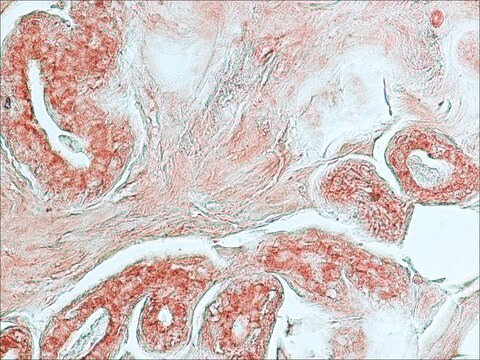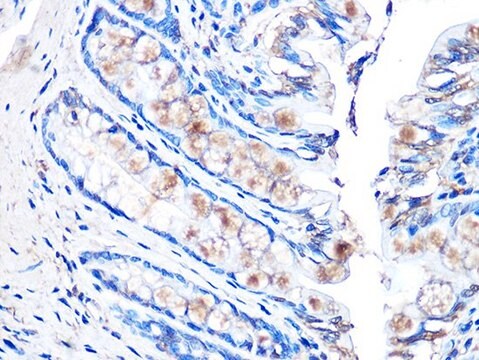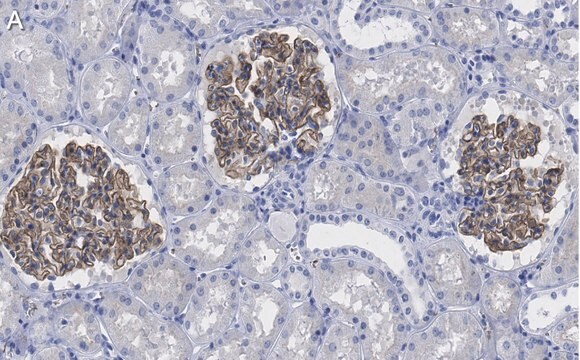推荐产品
生物源
mouse
品質等級
抗體表格
purified from hybridoma cell culture
抗體產品種類
primary antibodies
無性繁殖
CTD-19, monoclonal
形狀
buffered aqueous solution
物種活性
human, rabbit
濃度
~1.0 mg/mL
技術
immunoblotting: 2-4 μg/mL using human breast cancer MCF7 cell line
immunofluorescence: 5-10 μg/mL using HeLa cells
immunohistochemistry: 10-20 μg/mL using heat-retrieved formalin-fixed, paraffin-embedded human liver sections
同型
IgG2a
UniProt登錄號
運輸包裝
dry ice
儲存溫度
−20°C
目標翻譯後修改
unmodified
基因資訊
human ... CTSD(1509)
一般說明
Anti-Cathepsin D antibody, Mouse monoclonal (mouse IgG2a isotype) is derived from the CTD-19 hybridoma, produced by the fusion of mouse myeloma cells and splenocytes from BALB/c mouse immunized with cathepsin D purified from human liver. Cathepsin D (CatD or CTSD) is synthesized in the rough endoplasmic reticulum as pre-proprotein. After removal of signal peptide, the pro-CatD is targeted to endosomes to form an active, ~48 kDa, single-chain intermediate then to the lysosomes to form the fully active mature protease, composed of a ~30 kDa heavy chain and a ~14 kDa light chain.
免疫原
Cathepsin D Purified from human liver
應用
Anti-Cathepsin D antibody, Mouse monoclonal has been used in:
- immunoblotting
- immunohistochemistry
- immunofluorescence
生化/生理作用
CatD plays numerous physiological functions in the cells including metabolic degradation of intracellular proteins and the activation of enzymatic precursors. In the central nervous system, CatD is particularly important for the control of neuronal homeostasis, cell migration and interneuron communication. CatD-mediated proteolysis mediates the degradation of unfolded/oxidized protein aggregates in lysosome. The level of CatD synthesized by the cells is increased in response to mitogenic signals from estrogen, epidermal growth factor (EGF), fibroblast growth factor (FGF), and insulin like growth factor-I (IGF- I). The ability of tumor cells to invade the extracellular matrix has been attributed to cathepsins released by tumor cells or associated with its plasma membrane.
外觀
Solution in 0.01 M phosphate buffered saline, pH 7.4, containing 15 mM sodium azide.
未找到合适的产品?
试试我们的产品选型工具.
儲存類別代碼
10 - Combustible liquids
閃點(°F)
Not applicable
閃點(°C)
Not applicable
M J Duffy et al.
Clinical chemistry, 37(1), 101-104 (1991-01-01)
Cathepsin D (CD, EC 3.4.23.5) is a lysosomal protease induced by estrogen in certain estrogen receptor (ER)-positive breast cancer cell lines but produced constitutively by ER-negative cell lines. Our aims in this investigation were to study the distribution of CD
Nuclear cathepsin D enhances TRPS1 transcriptional repressor function to regulate cell cycle progression and transformation in human breast cancer cells
Bach AS, et al.
Oncotarget, 6(29), 28084-28084 (2015)
Cathepsin D as a therapeutic target in Alzheimer's disease.
Di Domenico F, et al.
Expert Opinion on Therapeutic Targets, 20(12), 1393-1395 (2016)
The role of cathepsin D in the pathogenesis of human neurodegenerative disorders
Vidoni C, et al.
Medicinal Research Reviews, 36(5), 845-870 (2016)
Veronika Stoka et al.
Ageing research reviews, 32, 22-37 (2016-04-30)
Lysosomes and lysosomal hydrolases, including the cathepsins, have been shown to change their properties with aging brain a long time ago, although their function was not really understood. The first biochemical and clinical studies were followed by a major expansion
我们的科学家团队拥有各种研究领域经验,包括生命科学、材料科学、化学合成、色谱、分析及许多其他领域.
联系技术服务部门







